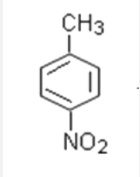The compound (C) in the given sequence of reaction is ,
C6H5OHNaOH−−−→(A)CO2−−→(B)HCl−−→(C)
chlorobenzene
Benzoic acid
Salicyladehyde
Salicylic acid
The correct Answer is:D
To determine the compound (C) in the given sequence of reactions, we will analyze each step of the reactions involving phenol (C6H5OH).
1. Identify the starting compound:
The starting compound is phenol, which has the molecular formula C6H5OH.
2. Reaction with Sodium Hydroxide (NaOH):
When phenol reacts with sodium hydroxide, it forms the sodium salt of phenol. This is a deprotonation reaction where the hydroxyl (-OH) group of phenol loses a hydrogen ion (H+) and forms sodium phenoxide (C6H5O^- Na^+).
Reaction:
C6H5OH + NaOH → C6H5O^- Na^+ + H2O
Intermediate (A): Sodium phenoxide (C6H5O^- Na^+)
3. Reaction with Carbon Dioxide (CO2):
The sodium phenoxide then reacts with carbon dioxide under specific conditions (high temperature and pressure). This reaction is known as the Kolbe-Schmitt reaction, which results in the formation of sodium salicylate.
Reaction:
C6H5O^- Na^+ + CO2 → C6H4(OH)(COO^- Na^+) (sodium salicylate)
Intermediate (B): Sodium salicylate (C6H4(OH)(COO^- Na^+))
4. Reaction with Hydrochloric Acid (HCl):
Finally, when sodium salicylate is treated with hydrochloric acid, it leads to the formation of salicylic acid by protonating the carboxylate group.
Reaction:
C6H4(OH)(COO^- Na^+) + HCl → C6H4(OH)(COOH) + NaCl
Final Compound (C): Salicylic acid (C6H4(OH)(COOH))
Conclusion:
The compound (C) in the given sequence of reactions is salicylic acid.
The starting compound is phenol, which has the molecular formula C6H5OH.
When phenol reacts with sodium hydroxide, it forms the sodium salt of phenol. This is a deprotonation reaction where the hydroxyl (-OH) group of phenol loses a hydrogen ion (H+) and forms sodium phenoxide (C6H5O^- Na^+).
C6H5OH + NaOH → C6H5O^- Na^+ + H2O
The sodium phenoxide then reacts with carbon dioxide under specific conditions (high temperature and pressure). This reaction is known as the Kolbe-Schmitt reaction, which results in the formation of sodium salicylate.
C6H5O^- Na^+ + CO2 → C6H4(OH)(COO^- Na^+) (sodium salicylate)
Finally, when sodium salicylate is treated with hydrochloric acid, it leads to the formation of salicylic acid by protonating the carboxylate group.
C6H4(OH)(COO^- Na^+) + HCl → C6H4(OH)(COOH) + NaCl
The compound (C) in the given sequence of reactions is salicylic acid.
Similar Questions
In the given reaction sequence C6H5−COOHSOCl2−−−→(A)NH2OH−−−−→(B)NaOH/Δ−−−−−−→(C),
'C' will be
View SolutionWhat is the end product in the following sequence of reactions ?
C6H5COOHPCl5−−→P2NH3−−→QReduction−−−−−→R
View SolutionThe end product of the reaction,
Ethyl amine HNO2−−−→(A)PCl5−−→(B)KCN−−→(C) (C) is,
View SolutionConsider the following sequence of reactions :
C6H5CH3Cl2−−→p−ClC6H4CH3NBS−−→(X)Mg−−→(Y)(i)ethylene oxide−−−−−−−−−−→(Z)
Final product (Z) is
View SolutionGive the strutures of (A), (B) and (C ) in the following reactions :
C6H5NO2Fe/HCI−−−−−→(A)HNO2−−−→273K(B)C6H5OH−−−−→(C)
View SolutionLet →C=→A+→B then :
View SolutionIdentify the product (E) in the following sequence of reactions.
 Br2−−→ASn/HCl−−−−→BNaNO2/HCl−−−−−−−−−−→273−278KCH2O/H3PO2−−−−−−−→DKMnO4−−−−−−−→OH−E
Br2−−→ASn/HCl−−−−→BNaNO2/HCl−−−−−−−−−−→273−278KCH2O/H3PO2−−−−−−−→DKMnO4−−−−−−−→OH−E
View SolutionConsider the following sequence of reactions
C2H5C≡CHCH3MgBr−−−−−→A(1)HCHO−−−−−−→(2)H2O+B
The product (B) is
View SolutionThe product D of the reaction CH3ClKCN−−→(A)H2O−−→(B)NH3−−→(C)Δ−−→(D) is
View SolutionThe compound (A) in the following reaction sequence is:
(A) PCl5−−→ (B) Alc KOH−−−−→ ( C) H2/Ni−−−→
Propane :
View Solution